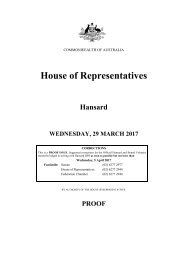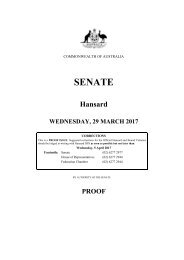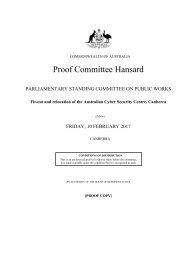SENATE
2f60l5b
2f60l5b
Create successful ePaper yourself
Turn your PDF publications into a flip-book with our unique Google optimized e-Paper software.
Friday, 21 October 2016 Senate Page 25<br />
Senator McCARTHY: Yes.<br />
Mr O'Neill: We offer terms of up to 32 years.<br />
Senator DODSON: I understand the challenge of people trying to access loans for houses, homes and<br />
businesses. I just want to explore with you the notion of the risk factors that govern the way you set your interest<br />
and your loan amounts and periods in relation to the sustaining of the quantum of your cash flow. Can you<br />
explain that to me? What are the risk factors that are at play here that either enable you to respond, which is part<br />
of what the minister's question was, or for those people who come before you who do not meet all these criteria,<br />
because you have a certain risk profile that you have? And that risk profile goes to the outlays that you are going<br />
to make in relation to the loan, but also in terms of the sustainability of your quantum of your reserve. Can you<br />
explain that to me, please?<br />
Mr Fry: I just want to frame it up so that Leo and Peter can add more meat to this discussion on it. The<br />
board—we deliberate on the matter of risk. We do it probably every quarter around home loans. The issue for us<br />
is this: if we get 4,000—or whatever it is—inquiries what is the see-through return in providing a home loan for<br />
those individuals that managed to get there. The first thing is to acknowledge and understand that those who do<br />
get the loan are never going to get it from the bank. That is the very first thing. A great portion of them that are<br />
sitting inside that four or five—regardless of what the inquiry is, they are going to struggle to put together the<br />
actual package that will satisfy getting into a home loan. Then, from a risk point of view, the challenge then is: do<br />
we provide a home loan to an individual knowing that they are right on the margin and that they may very well<br />
end up in a distressed environment where we are having to foreclose the home on them because they just<br />
cannot—they have lost their job or their business has gone broke. It is not just a question of looking at risk from a<br />
monetary perspective. It is a risk on the community and the individual themselves. So when we look at risk it is<br />
not clearly just about the financial constructs to this and whether it is a good spend or a good investment.<br />
Senator DODSON: I was wondering also whether there is equity participation considerations that go to<br />
mitigate that risk, particularly if Indigenous people are owning their own land or, in the case of native title<br />
holders, bringing the land to market, as it were. What is the appetite for risk in that situation? I am just trying to<br />
see the innovative ways in which you are trying to respond to some of this—if there are innovative ways.<br />
Mr Fry: I can actually answer partly that because, only as recently as about three weeks ago, that very<br />
question was being discussed between Leo, myself and Peter—how we look at what ILC is doing out on the lands<br />
and how we tie in any employment opportunities to home loans arranged for purchasing of houses in those near<br />
remote areas. One of the considerations is how we might peg or lock in where they are tied into ILC activity to<br />
actually get them to commit to passing on a portion of that employment money into acquiring a home loan. These<br />
are the things that we are thinking about. These are things that we have been crunching and looking at. We are not<br />
sitting back just waiting for people to come in; we are actually—<br />
Senator DODSON: Or let the market determine what you are doing.<br />
Mr Fry: That is right—or let the market determine. We are actively doing this on a regular basis. As I alluded<br />
to earlier, I meet with them bi-weekly. I can assure you I have a very long list which is probably more extensive<br />
to the questions that are being asked. It is all about how we are: operating as a commercial entity; delivering our<br />
products; innovating on those products and expanding them into the areas that we may not traditionally be in, and<br />
reaching into them and to see what we can do; but, more importantly, how we can align this with the activities of<br />
the ILC or any other body that is working in that region with those Indigenous groups.<br />
Senator McCARTHY: I have just two quick questions, and you might want to take this one on notice, Mr Bator.<br />
You said 495 home loans were successful. How many people actually applied overall in 2014-15?<br />
Mr Bator: I can get those details for you.<br />
Senator McCARTHY: In terms of Aboriginal land—like, for example, the Northern Territory, where over 50<br />
per cent of the land mass is ALRA—do you loan to Indigenous families on Aboriginal land?<br />
Mr Bator: We do. That is one of the challenges, I think, that Senator Dodson was referring to. We have<br />
responsible lending practice that we like to follow. So if there is no market for a house, what is the challenge we<br />
are going to put up to a person?<br />
They may well be able to pay or employment opportunities might go and they might not have an opportunity to<br />
sell the house. So we are trying to think through, as well as giving the loan, the next steps in some regions like<br />
that.<br />
An important point, which the chair was making as well, is how we can bring all of our tools to play in terms of<br />
business start-up, investments and ILC activity to try to create an environment where there are ongoing<br />
FINANCE AND PUBLIC ADMINISTRATION LEGISLATION COMMITTEE















